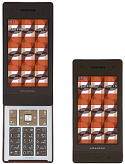Linux Mobile group readies 2Q push
Jul 31, 2009 — by Eric Brown — from the LinuxDevices Archive — views The LiMo Foundation will soon announce more handsets, said executive director Morgan Gillis, in an interview with LinuxDevices. Gillis, who sounded off on Intel's Wind River acquisition, Android, Chrome OS, Symbian, and more, said the mid-August announcement will be followed by bigger announcements in October as LiMo R2 reaches market.
The LiMo Foundation will soon announce more handsets, said executive director Morgan Gillis, in an interview with LinuxDevices. Gillis, who sounded off on Intel's Wind River acquisition, Android, Chrome OS, Symbian, and more, said the mid-August announcement will be followed by bigger announcements in October as LiMo R2 reaches market.
In June, the LiMo Foundation announced the completion of its second-generation R2 mobile phone specification for its LiMo (Linux Mobile) Platform. APIs corresponding to the R2 platform will be released publicly in the early fall, and handsets based on the platform will begin to appear by the fourth quarter, said the 33-member group. Over 30 LiMo-compliant phones have shipped to date, including NEC's Docomo Smart series N-04A (pictured below, at right), which like most LiMo phones to date, has been designed for NTT's DoCoMo network in Japan.
 |
The R2 spec offers new location-based services (LBS), multimedia, personal information management (PIM), and security features for LiMo handsets, the LiMo Foundation says. Perhaps more significantly, R2 also includes support for the BONDI web-app interoperability spec developed by the Open Mobile Terminal Project (OMTP), an industry standards group backed by mobile operators.
Aimed at providing common web authoring tools to create rich-media apps and widgets that that can run on any LiMo R2 handset that support web runtimes, BONDI includes APIs that widgets can use to perform actions such as interface with peripherals, launch applications, and invoke messaging calls.
BONDI would appear to address some of the recent criticisms of LiMo, including those that appeared on LinuxDevices in March by VisionMobile Research Director Andreas Constantinou. The mobile analyst argued that the LiMo spec had gotten off to a slow start, and had not focused sufficiently on higher levels of the mobile stack, seen to be a key strength of Android and the iPhone.
Waiting for a true LiMo smartphone
Others have noted, meanwhile, that the first wave of LiMo phones, which were primarily upgraded versions of earlier Linux-based models from Motorola, as well as NTT DoCoMo-branded phones from Panasonic and NEC, have yet to reveal features in the same league as today's high-end smartphones. In fairness, however, LiMo has a broader focus than Android and the iPhone, and is intended to offer common middleware for feature phones as well as smartphones.
 |
In the interview held earlier this week, LiMo Executive Director Gillis said that R2 and BONDI address many of the critiques about the lack of upper layer activity. He also noted that while LiMo is not receiving the attention of other Linux-based platforms like Android and the new Palm Pre with its WebOS, a number of high-end smartphones, such as an LG prototype shown at left, are set to ship from major carriers around the world this Fall.
In February, LiMo announced that it had received carrier commitments from Orange, SK Telecom, Telefonica, Verizon Wireless, and Vodafone, in addition to its earlier NTT DoCoMo partnership, and Gillis suggests that more announcements may be forthcoming.
Gillis does not appear terribly concerned about the lack of publicity for LiMo, which is in a sense, by design. LiMo's lack of a single driving company, agenda, and brand identity, along with its flexible licensing, is key to what attracts carriers to the standard in the first place, he suggests. The interview with the LiMo Foundation's Morgan Gillis may be found by clicking on the link below:
An interview with LiMo's Morgan Gillis
This article was originally published on LinuxDevices.com and has been donated to the open source community by QuinStreet Inc. Please visit LinuxToday.com for up-to-date news and articles about Linux and open source.